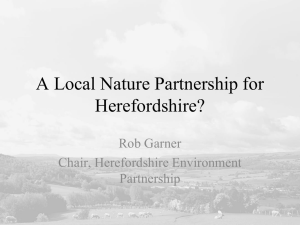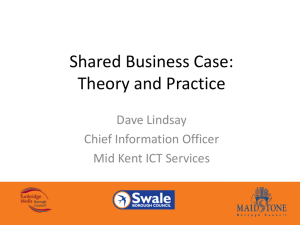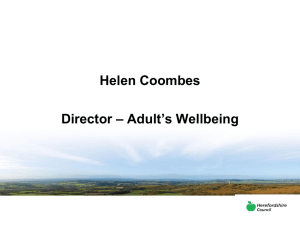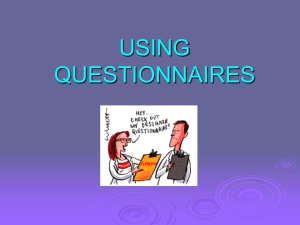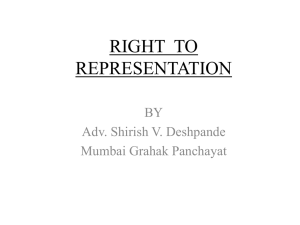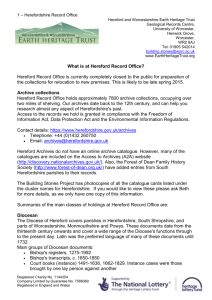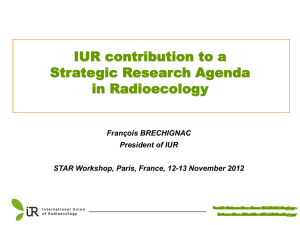WHO are you consulting?
advertisement
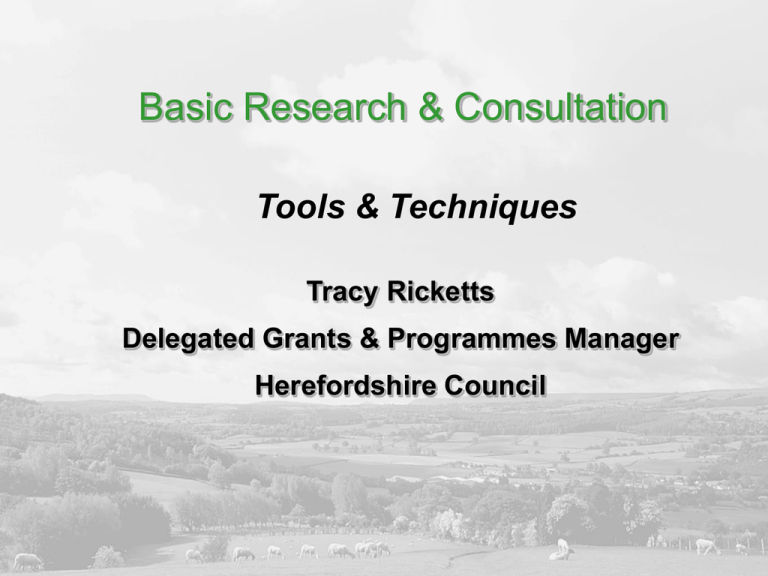
Basic Research & Consultation Tools & Techniques Tracy Ricketts Delegated Grants & Programmes Manager Herefordshire Council What this workshop will cover: Things to think about at the outset Overview of a range of consultation techniques Survey design Questionnaire Design Analysis Where to get assistance from Things to think about at the outset 1. 2. 3. 4. 5. 6. 7. 8. WHY are you consulting? WHAT do you need to find out? WHAT other research has been done? WHEN are you planning to consult? WHO are you consulting? HOW are you planning to consult? HOW is the data going to be processed & analysed HOW are you going to feedback the results? Techniques Many alternatives – choose method(s) to suit Main considerations ➢ ➢ ➢ Information sought – quantitative or qualitative? Target population – specific groups? Cost For quantitative information Best methods: Questionnaire surveys - Self-completion (postal or electronic) - Interview (telephone or face-to-face) (for usage & satisfaction levels) Ballots/referenda/deliberative polling (for decision making) Questionnaire surveys Who? People who live, work in or visit your area Service users and/or non-users Specific demographic groups How? Census or random sample – need list of names/addresses Citizens Panel Representative groups Self-select Cost? Depends on method, sample size & length of survey For qualitative information eg about experiences & problems Best methods: Interview (telephone or face to face) Focus groups Mystery shopping Planning for Real World cafe Focus groups Who? People who live or work in your area Service users and/or non-users Specific demographic groups How? User panel Citizens Panel Representative groups Cost? Depends on size/number of groups and availability of in-house trained facilitators Brief overview of types of techniques Document consultation Questionnaire Surveys (postal and electronic) Telephone Surveys Face-to-face Focus Groups Open/public meetings Feedback from frontline staff about Service Users Experiences Mystery shopping Brief overview of types of techniques contd. Comments Deliberative polling (referenda & ballots) People’s or World café Participatory budgeting Planning for Real Representative groups Citizens’ panel Other non-formal accepted information: In addition to the more structured and formal methods of acceptable information to support your quest, Herefordshire Council accepts the following:Letters of support Letters of complaint (if it goes in support of the action you’re seeking funding for!) 3. General anecdotal information supported by the more formal approach of consultation/evidence. All have to be relevant, proportionally, to the scheme you’re wishing to seek funding for to be deemed valid as evidence of need. 1. 2. Mix & match to suit...... 1. Set the scene - use data from your own monitoring records and any other ‘secondary data’ There may be more information than you realise! ‘A good operating rule is to consider a survey akin to surgery – to be used only after other possibilities have been exhausted’ (Robert Feber & PJ Verdoorn, Research Methods in Economics & Business (New York: MacMillan, 1962)) Mix & match to suit...... 2. To determine issues – use qualitative methods eg Planning for Real/Parish Plan 3. To obtain statistics to measure extent of issues – use quantitative methods eg postal surveys 4. To obtain more information about specific issues – use qualitative methods eg focus groups See Guidance for more comprehensive list & points to consider Survey design If you want to gain statistics for the population from results for a sample, need to consider: ➢ ➢ ➢ ➢ Target population – list of names/addresses Sampling method - simple random or stratified? Sample size – to give required confidence limits Non-response: how to minimise (design, covering letter, pilot, reminders) Questionnaire design Based on your experience (either producing or responding to a questionnaire survey), what would you say are the main ‘dos & don'ts’? Questionnaire design – quick tips Tell people why you are doing the consultation Keep it short & simple Only ask questions if results can be used/acted upon Make questions as neutral as possible Avoid ambiguity Only ask one question at a time Be as specific as possible Be clear about confidentiality/anonymity Include relevant diversity monitoring questions Question types Yes/No Single choice Multiple choice Ranked choice Numerical scale Numeric Free Text Return rates: What is good, bad or of no use …….. A lot of depends! It is generally expected that 30% and above is a good response 20% would be expected for a general ‘pick up’ consultation Less than 10% would not be representative or deemed eligible as evidence of need Spot the errors! Identify all the things that are wrong with this questionnaire and suggest changes to overcome problems. Analysis – things to consider How? Excel or specialist software eg SNAP, SPSS Staff/Volunteer capacity (time & skills) If being done by you or your staff/volunteers Weighting (to correct for under/over representation of specific groups in sample) Bases for calculating percentages Confidence intervals Cross-tabulations (to see links) Graphs (to see patterns & trends) Bases for calculating percentages In a survey people were asked a number of questions including: Do you think Herefordshire is a great place to live? 600 people returned the questionnaire 500 people answered the question: 300 said "Yes" 100 said "No" 100 said "Don't know" What proportion said "Yes”, was it: A. 50% B. 60% C. 75% General pointers ……. Ensure consultation is the right approach for the situation and the time Make sure it is not seen as a token gesture and the decision is a fait accompli Plan carefully and allow adequate time (Consultation Plan, Logging Form) Test your questionnaire before going ‘live’ Publish your results – what are the actions to be taken as a result of the consultation and why – be honest! General pointers contd ……….. Make sure it is the right people undertaking the consultation – impacts on engagement Refer to Consultation & Survey Guidance Ask for advice/support from your local support mechanisms In short, do all that you can to ensure that the data is robust – otherwise you've wasted your time & that of all those involved! Sources of information: Majority of Councils do have a research team of some description Regional Observatories who carry out regional statistical gathering may have local contacts (Welsh Data Unit in Wales) Other websites Neighbourhood statistics – www.neighbourhood.statistics.gov.uk Sources of information contd. www.nomisweb.co.uk for particular topic Rural issues, the Commission for Rural Communities is another source – www.ruralcommunities.gov.uk. General government departments publish their own data DWP, DCSF, CLG. Information specific to Herefordshire Herefordshire Council’s Research Team contact (01432) 260498 email researchteam@herefordshire.gov.uk State of Herefordshire Report Ward Area Profiles Topic related information/data Many thanks for listening and participating……….. Contact details: Tracy Ricketts, Delegated Grants & Programmes Manager Tel – 01432 260634 Email – tar@herefordshire.gov.uk
